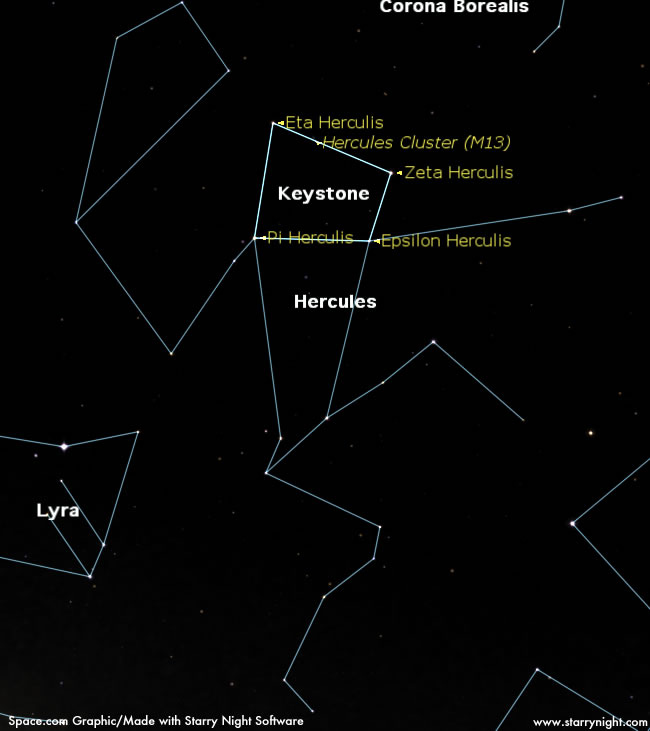
As the sky grows dark on very clear evenings this week, anancient star pattern can be found almost directly overhead: Hercules, themighty strong man and hero of many legends.
The stars that compose this pattern are, for the most part,rather dim, and it seems rather incongruent that for such a powerful figure,the representative constellation is rather weak. Indeed, there is really nostriking pattern to be found here. It is supposed to represent a kneeling manand was known as the "Kneeling One" in pre-Greek cultures.
A check of a number of various stargazing guidebooks mightsuggest you look for a large crooked letter H, or even a butterfly that can betraced out in several different ways. In "The Stars/A New Way to SeeThem," author H.A. Rey (1898-1977) managed topicture Hercules as a kneeling man swinging a club.
Within the center of this constellation is a pattern that isoften labeled the "Keystone," and is composed of Eta, Pi, Epsilon,and Zeta Herculis. It is an asterism, which is defined as a distinctivegrouping of stars forming part of the recognized constellation outlines, orlying within its boundaries. Ranging in size from sprawling naked-eye figuresto minute stellar settings, they are found in every quarter of the sky and atall seasons of the year. The larger asterisms – such as the Big Dipper in UrsaMajor and the Great Square of Pegasus – are often better known than their hostconstellations.
Some might not be acquainted with what a keystone is. Manyarches are built with a large, central stone that helps to make the arch selfsupporting. The keystone was one of the most significant ancient architecturaldiscoveries, along with the vault. Pennsylvania acquired its nickname "TheKeystone State" because of its central location among the 13 originalAmerican colonies. If you have ever traveled on "America's First Superhighway," the Pennsylvania Turnpike, you might recall thekeystone symbol found on its traffic signs. And the keystone symbol can also befound on the logo for the Little League (whose World Series is played in Williamsport, Pennsylvania).
Cosmic Chrysanthemum
Admittedly, the Hercules Keystone is slightly lopsided, butthen few star pictures are perfect (even the famous Great Square of Pegasuslooks more rectangular that square-like). A third of the way down the Keystone'swestern edge is the famous starcluster M 13, which may be glimpsed with the unaided eye. It is acelebrated object; the brightest and most dramatic example of a globularcluster north of the celestial equator, often referred simply as "TheGreat Hercules Cluster." It's a concentration of over 100,000 stars, locatedat a distance of roughly 23,000 light years from us.
Get the Space.com Newsletter
Breaking space news, the latest updates on rocket launches, skywatching events and more!
Globular clusters are masses of stars that typically lie onthe outskirts of our galaxy.
If you have good binoculars, you should have no difficultyin locating M 13 for it will appear as a hazy-looking "star" of aboutsixth magnitude (which is about the threshold of naked-eye visibility). In asmall telescope it will appear as a bright, round nebula about one-third theapparent size of the Moon. With a 4 to 6-inch telescope, the round glow beginsto become resolved into hundreds of tiny star-points. In telescopes of12-inches or larger a truly memorable view is obtained. Astronomer Robert H.Baker (1880-1962) called it a "wonderful chrysanthemum of stars."
For those who regularly attend the annual Stellafaneconvention, just outside of Springfield, Vermont (which in 2007 takes placeAug. 9-12), the Great Hercules Cluster is the object that Stellafane's 12-inchPorter turret telescope is directed toward most often.
Many years ago, the legendary deep sky observer, WalterScott Houston (1912-1993) – known as "Scotty" – noticed a long lineof people patiently waiting their turn to get a view through the eyepiece."What are you folks looking at?" he asked as he poked his headthrough the observatory door. From out of the darkness, came the response: M13. "M 13?" replied Scotty, with a tinge of incredulity. "So manypeople have looked at it you would think it'd be all worn out by now!"
- Online Sky Maps and More
- Sky Calendar & Moon Phases
- Astrophotography 101
Joe Rao serves as an instructor and guest lecturer at New York's Hayden Planetarium. He writes about astronomy for The New York Times and otherpublications, and he is also an on-camera meteorologist for News 12 Westchester, New York.
Join our Space Forums to keep talking space on the latest missions, night sky and more! And if you have a news tip, correction or comment, let us know at: community@space.com.

Joe Rao is Space.com's skywatching columnist, as well as a veteran meteorologist and eclipse chaser who also serves as an instructor and guest lecturer at New York's Hayden Planetarium. He writes about astronomy for Natural History magazine, Sky & Telescope and other publications. Joe is an 8-time Emmy-nominated meteorologist who served the Putnam Valley region of New York for over 21 years. You can find him on Twitter and YouTube tracking lunar and solar eclipses, meteor showers and more. To find out Joe's latest project, visit him on Twitter.









